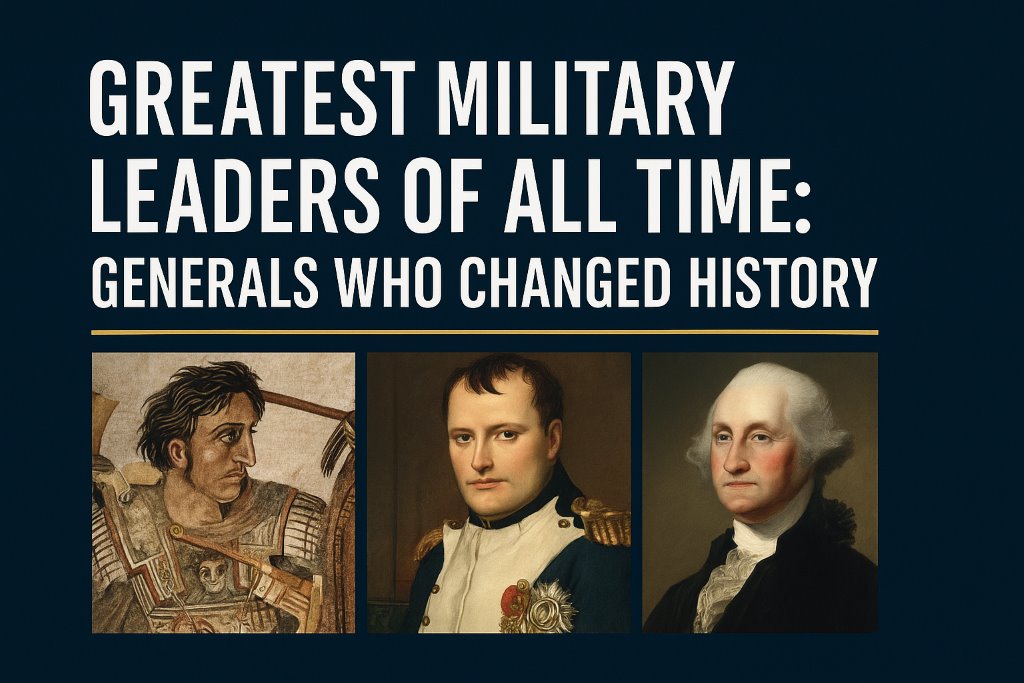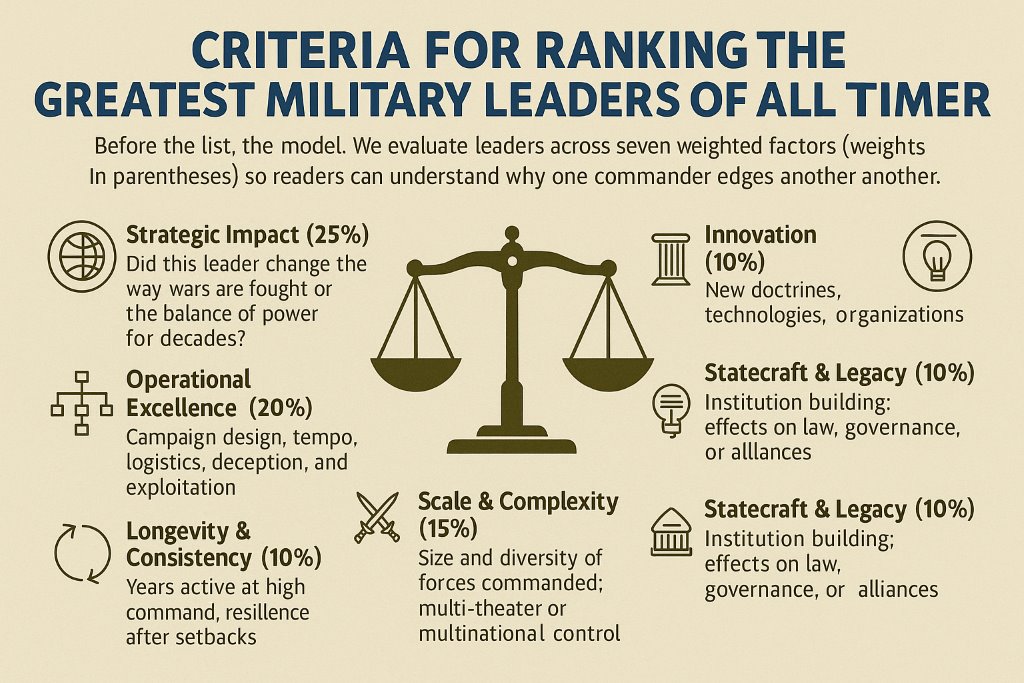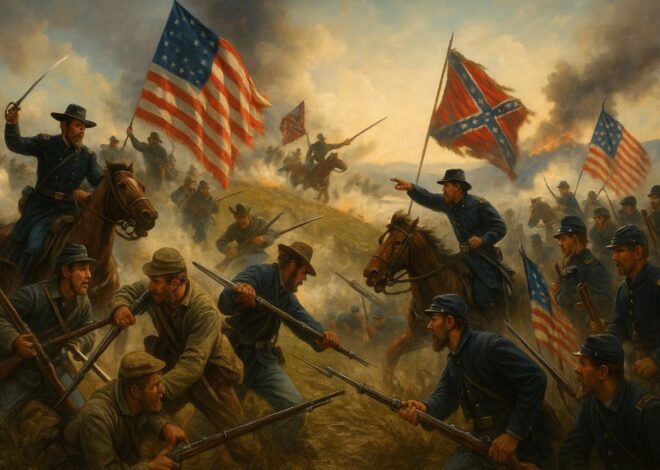
Greatest Military Leaders of All Time
Criteria for Ranking the greatest military leaders of all time ranked
Before the list, the model. We evaluate leaders across seven weighted factors (weights in parentheses) so readers can understand why one commander edges another.
- Strategic Impact (25%): Did this leader change the way wars are fought or the balance of power for decades?
- Operational Excellence (20%): Campaign design, tempo, logistics, deception, and exploitation.
- Tactical Mastery (10%): Battle-day decisions—formations, timing, terrain use.
- Scale & Complexity (15%): Size and diversity of forces commanded; multi-theater or multinational control.
- Longevity & Consistency (10%): Years active at high command; resilience after setbacks.
- Innovation (10%): New doctrines, technologies, organizations.
- Statecraft & Legacy (10%): Institution building; effects on law, governance, or alliances.

*Notes: We avoid body-count “scorekeeping” and do not reward atrocities. Casualty figures and army sizes vary by source; here they’re used cautiously to convey order of magnitude, not as tiebreakers.
Top 15 (At-a-Glance): Our Working Ranking
| Rank | Leader | Era | Signature Wins / Contributions | Why They Rank |
|---|---|---|---|---|
| 1 | Genghis Khan | c.1162–1227 | Khwarezm, Indus, Eurasian steppe unification | Strategic mobility, operational tempo, organizational innovation; foundation of largest contiguous empire. |
| 2 | Alexander the Great | 356–323 BCE | Granicus, Issus, Gaugamela | Undefeated in set-piece battles; rapid multi-theater campaigning; logistics across deserts and mountains. |
| 3 | Napoleon Bonaparte | 1769–1821 | Austerlitz, Jena, Wagram | Operational art; corps system; mass conscription; Europe-wide realignment despite ultimate defeat. |
| 4 | Hannibal Barca | 247–c.182 BCE | Trebia, Trasimene, Cannae | Encirclement mastery; coalition fracturing; strategic reach into Italy against the odds. |
| 5 | Julius Caesar | 100–44 BCE | Gallic Wars, Pharsalus | Campaign endurance; civic-military reformer; speed of decision and integration of intelligence with maneuver. |
| 6 | Saladin | 1137–1193 | Hattin, Jerusalem (1187) | Coalition building; strategic patience; combined political and military unification. |
| 7 | Subutai | c.1175–1248 | Kalka, Mohi | Mongol grand strategist; multi-axis operations over thousands of kilometers. |
| 8 | Admiral Horatio Nelson | 1758–1805 | Nile, Copenhagen, Trafalgar | Decisive naval tactics; command culture and initiative; sea control that throttled Napoleon. |
| 9 | Arthur Wellesley (Duke of Wellington) | 1769–1852 | Peninsula War, Waterloo | Logistics and coalition warfare; defensive mastery; attrition balanced with maneuver. |
| 10 | Ulysses S. Grant | 1822–1885 | Vicksburg, Overland, Appomattox | Operational persistence; theater synchronization; war-ending strategy. |
| 11 | Georgy Zhukov | 1896–1974 | Moscow, Stalingrad (coord.), Kursk, Berlin | Front-level orchestration; industrial-scale offensives; learning cycle against the Wehrmacht. |
| 12 | Dwight D. Eisenhower | 1890–1969 | TORCH, OVERLORD, Europe 1944–45 | Supreme coalition command; logistics and alliance management at continent scale. |
| 13 | Erwin Rommel | 1891–1944 | France 1940 (7th Panzer), North Africa 1941–42 | Operational aggression; combined-arms flair; limitations at strategic level noted. |
| 14 | George S. Patton | 1885–1945 | Sicily, Lorraine, Relief of Bastogne | Relentless tempo; exploitation; logistics-driven maneuver at speed. |
| 15 | Tokugawa Ieyasu | 1543–1616 | Sekigahara | State-building via decisive victory; long peace through institutional design. |
Rankings are arguable by design. Swap Wellington and Nelson? Move Zhukov above Grant? Fair debates. The framework above keeps those arguments grounded in comparable factors.
Ancient World Commanders
Alexander the Great
Alexander blends speed, logistics, and ruthless focus. From 334–323 BCE, he took on field armies larger on paper and beat them through maneuver (Granicus), flanking (Issus), and battlefield geometry (Gaugamela). He integrated siegecraft (Tyre), river crossings (Hydaspes), and civil administration to hold what he took. Among the greatest generals of all time, he’s the archetype: undefeated in major pitched battles, operating across deserts and mountain chains with supply lines that shouldn’t have worked—but did.
- Operational hallmark: multi-axis advances that forced opponents to split.
- Innovation: combined heavy cavalry shock with flexible phalanx and specialist troops.
- Why he ranks high: near-perfect battlefield record plus empire-scale outcomes.
Julius Caesar
Caesar wasn’t just a battlefield winner; he was a political engineer who used military success to reshape a republic. In Gaul he mixed engineering (bridges, fortifications), intelligence, and diplomacy to isolate enemies. In civil war he won fast (Pharsalus) and forgave liberally to stabilize. As a strategist, he kept tempo high: hit, consolidate, legislate. That blend—sword and statute—keeps him among the greatest military leaders of all time even for critics who dislike the outcome.
Hannibal Barca
Hannibal’s Italian campaign is a masterclass in initiative. He crossed the Alps with war elephants, then shredded Roman armies at Trebia, Lake Trasimene (ambush), and Cannae (double envelopment). Rome’s depth saved it, but tactically Hannibal is the reference model. Any discussion of famous warriors or the greatest generals of all time features his name—proof that brilliance can dazzle even in defeat.
Medieval and Early Modern Leaders
Genghis Khan
From scattered steppe tribes, Temüjin built a war machine. He reorganized society into decimal units (10/100/1,000/10,000), integrated subject peoples, and enforced merit over birth. Strategically he’s second to none: long-range deception, synchronized columns hundreds of miles apart, and exploitation cycles that rolled from one victory into the next. His conquests laid the base for an empire that would reach from Korea to the Carpathians.
- Operational hallmark: strategic mobility and relentless reconnaissance.
- Innovation: communications (relay posts), codified law (Yassa), engineer corps.
- Why he ranks #1 here: systemic superiority that survived leaders, theaters, and decades.
Napoleon Bonaparte
Napoleon codified operational art: independent corps, living off the land, rapid concentration for decisive blows. Austerlitz remains an apex example of deception and timing. Failures (Spain’s insurgency, Russia’s depth) show limits of overreach—but they don’t erase the decades of dominance or his administrative statecraft (Code Napoléon) that outlived him.
Saladin
Saladin unified fractured polities, wore down crusader logistics, and forced a decision at Hattin before retaking Jerusalem (1187). He scored high in both statecraft and strategy—rare. His legacy also includes norms of chivalric conduct and negotiated restraint, which strengthened rather than weakened his political position.
Leaders of the Modern Era
George Washington
What makes George Washington one of the greatest military leaders of all time? Not raw win-loss stats. Strategy. He preserved the Continental Army under extreme scarcity, avoided annihilation battles, exploited intelligence (Culper Ring), and struck opportunistically (Trenton, Princeton). He understood war’s political dimension: civil-military restraint, cooperation with Congress, and postwar abdication that made the republic viable. In Ranking terms: high strategic impact, high legacy, moderate tactical flash—yet essential to American independence.
Dwight D. Eisenhower
Eisenhower’s genius wasn’t a single battlefield; it was systems integration. As Supreme Allied Commander he managed a multinational coalition, orchestrated amphibious landings (OVERLORD), and kept political friction from breaking operational timelines. His score spikes in Scale & Complexity and Statecraft—because sometimes the greatest victories are coalition victories.
Erwin Rommel
Rommel’s tactical and operational aggression in North Africa made him a legend—fast exploitation, combined arms, and psychological pressure. Limitations at the strategic level (supply, air/sea control he couldn’t fix) cap his ranking, but in the “how to punch above your weight” category he remains canonical.
Other Influential Modern Generals (Brief Profiles)
- Georgy Zhukov: Master of industrial-scale offensives; coordinated fronts at Moscow, Stalingrad (with others), Kursk, and Berlin.
- Arthur Wellesley (Duke of Wellington): Logistics, defensive geometry, coalition management; Waterloo’s steady hand.
- Horatio Nelson: Decisive naval action—Nile and Trafalgar reshaped sea power doctrine.
- Isoroku Yamamoto: Operational reach and carrier warfare concepts; strategic misjudgments later.
- Chester Nimitz: Operational sequencing across the Central Pacific; logistics as decisive force.
- Mikhail Kutuzov: Strategic depth and attrition against Napoleon—trading space for time.
- Helmuth von Moltke the Elder: Rail mobilization and mission command (Auftragstaktik) for Prussian victories.
Greatest US Military Leaders of All Time
We break out American commanders since users often search for the greatest US military leaders of all time specifically. Here’s our focused ranking trio, with why each matters in a statistics-minded list.
Ulysses S. Grant
Grant wins on theater synthesis. He linked the Mississippi campaign (Vicksburg) to eastern pressure (Overland Campaign) and forced surrender at Appomattox. Metrics in his favor: multi-theater coordination, sustained pressure, high adaptability after early-career setbacks, and war-ending effect. He also modernized command by using telegraphy and written intent to align dispersed forces.
Douglas MacArthur
Strategic vision with risks. Island-hopping in the Southwest Pacific and the Inchon landing in Korea were high-payoff gambles enabled by logistics, naval coordination, and deception. Scores high in Innovation and Operational audacity; strategic civil-military friction lowers Statecraft marks late in career—but the results column remains heavy.
George S. Patton
Patton weaponized tempo. From Sicily’s turnaround to the Third Army’s dash across France and the pivot to relieve Bastogne, he proved that logistics is the skeleton of maneuver. In rankings, he rates very high on Operational Excellence and Exploitation; moderate on coalition politics.
Rankings Deep Dive: Why These Leaders Edge Their Peers
Ranking is comparison. Here are three instructive “close calls” that show how the model works.
- Napoleon vs. Wellington: Napoleon wins on innovation and volume of decisive victories; Wellington counters with coalition orchestration and strategic restraint. Head-to-head at Waterloo, Wellington plus Blücher is the key context—coalition math matters.
- Grant vs. Lee: Lee’s tactical brilliance is undeniable; Grant’s operational integration ended the war. If your metric is “who forced strategic decision,” Grant ranks higher.
- Hannibal vs. Caesar: Hannibal’s battle genius vs. Caesar’s campaign-plus-statecraft package. The latter scores higher in Longevity & Legacy, tipping the scale.
Data Notes: Scales, Sizes, and the Problem of Numbers
Ancient headcounts are often inflated; modern ones are audited but still disputed. Use figures as brackets, not decimals. What matters for rankings is comparative scale:
- Operational span: Alexander fought from the Aegean to the Indus (~3,000+ km); Mongol campaigns routinely synchronized forces across even larger spaces.
- Force size: Napoleonic campaigns deployed hundreds of thousands; WWII fronts involved millions under commanders like Zhukov and Eisenhower.
- Tempo: Patton’s Third Army advanced hundreds of miles in weeks; Mongol columns crossed deserts in seasonally optimal windows using relay intelligence.
Frequently Debated Omissions (and Where They’d Fit)
- Scipio Africanus: Operational counter to Hannibal; would slot around ranks 10–15 depending on weight given to Zama and Iberian campaigns.
- Frederick the Great: Operational maneuver and discipline; mid-teens ranking on this list.
- Saladin vs. Baybars: We favor Saladin for unification impact; Baybars for institutionalization of Mamluk power could rank just behind.
- Robert E. Lee: Tactical excellence; ranking affected by strategic outcome and resource asymmetry.
Lessons from the greatest leaders of all time
Across centuries, the best commanders repeat seven habits:
- Clarity of aim: Simple goals cascade clearly (Grant’s “find and fight,” Eisenhower’s “Germany first”).
- Tempo over perfection: Fast 80% solutions beat slow 100% plans (Patton, Subutai).
- Logistics first: Amateurs talk tactics; professionals move beans, bullets, and bandwidth (Wellington, Nimitz).
- Intelligence integration: Scouts to satellites—the loop that shrinks uncertainty (Hannibal’s recon, Washington’s networks).
- Deception and surprise: From Austerlitz’s feints to Inchon’s audacity.
- Coalition craft: Aligning allies matters as much as aligning brigades (Saladin, Eisenhower).
- Institution building: Codes, doctrines, and laws outlast victories (Napoleon’s civil code, Tokugawa’s peace order).
Methodological Appendix: How to Re-Rank with Your Own Weights
If you value battlefield brilliance over statecraft, bump Tactical Mastery to 20% and Statecraft to 5%—Hannibal rises, Eisenhower dips. Prefer lasting institutions? Raise Statecraft to 20%—Tokugawa climbs, Rommel falls. That’s the point: a transparent model lets readers challenge results without hand-waving.
What Defines a Military Legend?
Legends aren’t just winners; they’re problem-solvers who bend constraints – terrain, time, coalition, logistics – until strategy works. Our ranking favors leaders who delivered decisive change and left systems stronger (or, in some cases, frighteningly effective). Argue the order, adjust the weights, add your candidates. But keep the method. That’s how discussions about the greatest military leaders of all time get better—more evidence, fewer myths, clearer criteria.
Don’t forget to check out our article about Deadliest battles in history


